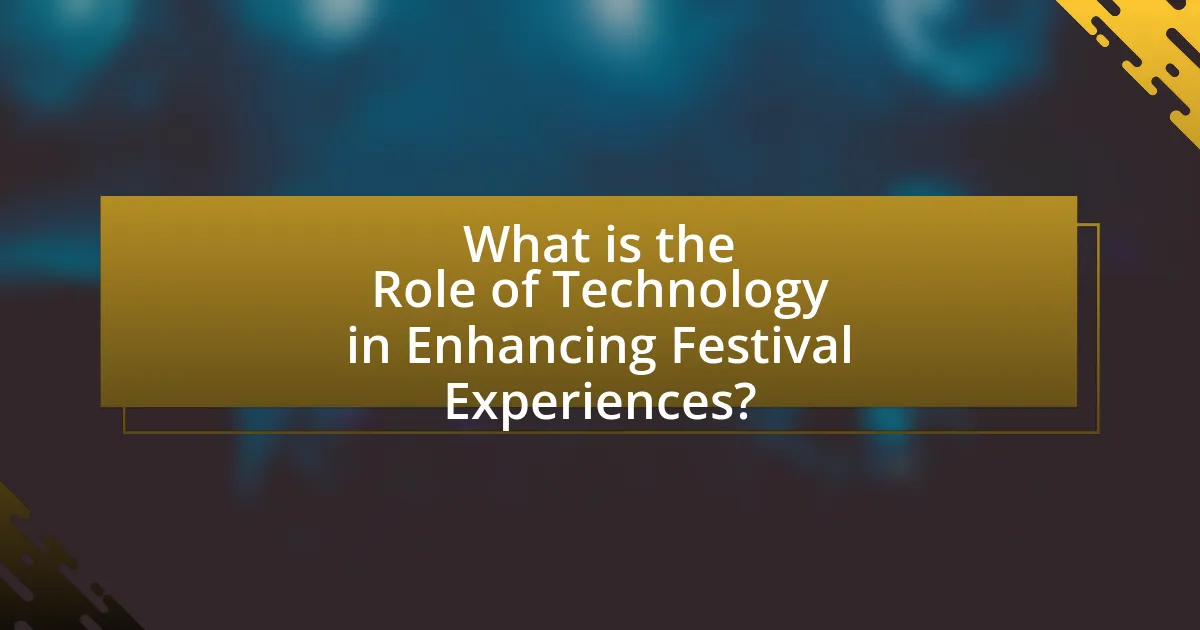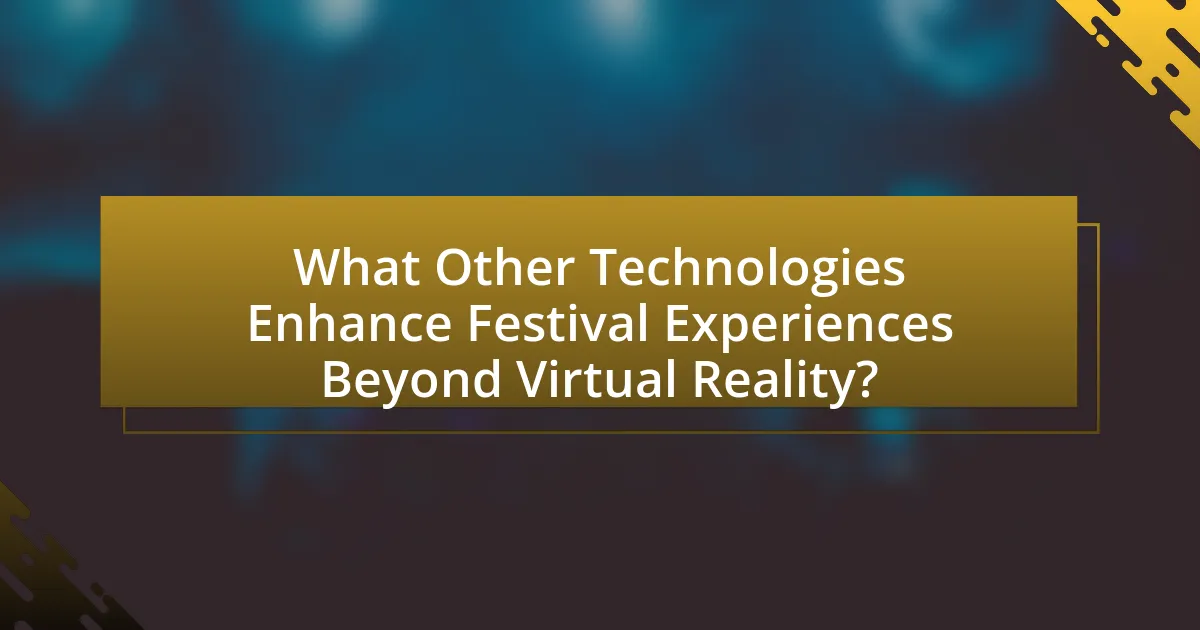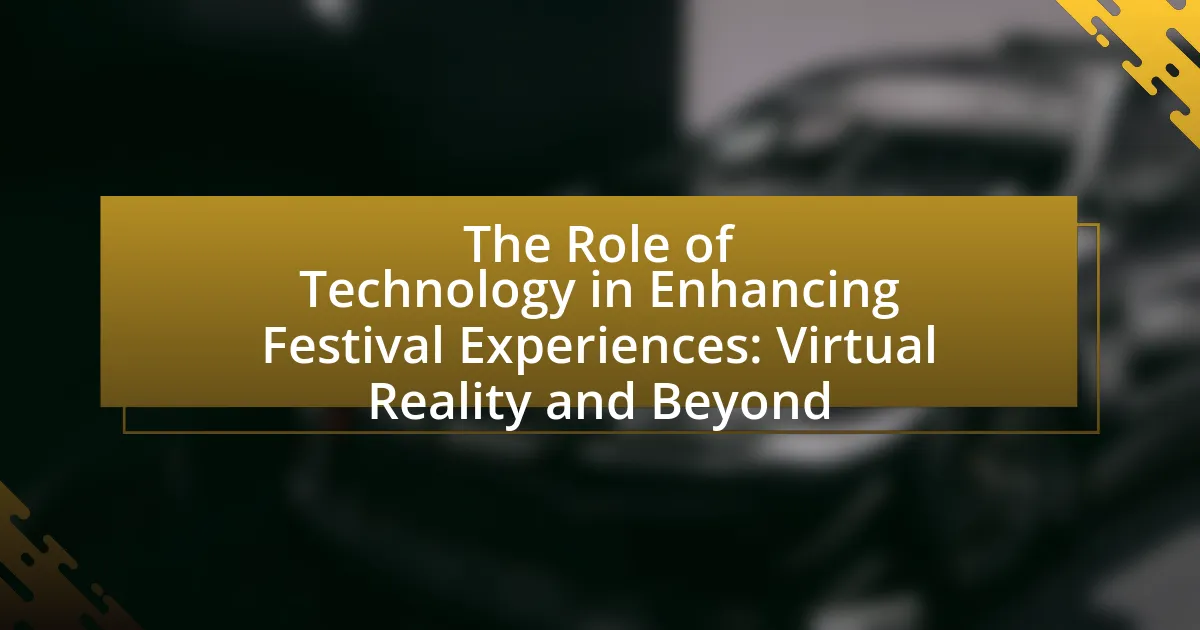The article examines the significant role of technology in enhancing festival experiences, with a particular focus on virtual reality (VR) and other innovations. It highlights how VR creates immersive environments that increase attendee satisfaction and engagement, while mobile applications streamline navigation and provide real-time updates. Additionally, the article discusses the impact of augmented reality, cashless payment systems, and social media on festival dynamics, emphasizing their contributions to accessibility, safety, and community building. Key challenges faced by festivals, such as crowd management and ticketing issues, are also addressed, showcasing how technology can effectively mitigate these concerns.

What is the Role of Technology in Enhancing Festival Experiences?
Technology plays a crucial role in enhancing festival experiences by providing immersive and interactive elements that engage attendees. For instance, virtual reality (VR) allows festival-goers to experience performances and environments in a more engaging way, creating a sense of presence that traditional formats cannot achieve. According to a study by the International Journal of Event Management Research, events that incorporated VR saw a 30% increase in attendee satisfaction compared to those that did not. Additionally, mobile applications facilitate real-time updates, personalized schedules, and social networking opportunities, further enriching the festival experience. These technological advancements not only improve engagement but also streamline logistics, making festivals more accessible and enjoyable for a diverse audience.
How does technology transform traditional festival experiences?
Technology transforms traditional festival experiences by integrating digital tools that enhance engagement, accessibility, and interactivity. For instance, virtual reality allows attendees to immerse themselves in festival environments from remote locations, broadening participation beyond geographical limitations. Additionally, mobile applications provide real-time information on schedules, artist line-ups, and navigation, improving the overall attendee experience. Data from a 2022 survey by Eventbrite indicated that 70% of festival-goers appreciated the use of technology for enhancing their experience, highlighting its significant impact on modern festivals.
What are the key technological innovations impacting festivals?
Key technological innovations impacting festivals include virtual reality (VR), augmented reality (AR), mobile applications, cashless payment systems, and live streaming technologies. VR and AR enhance attendee experiences by providing immersive environments and interactive elements, allowing users to engage with the festival in novel ways. Mobile applications streamline event management, offering features like schedules, maps, and social networking, which improve attendee navigation and interaction. Cashless payment systems simplify transactions, reducing wait times and enhancing security. Live streaming technologies enable remote participation, expanding audience reach and engagement beyond physical attendance. These innovations collectively transform how festivals are experienced, making them more accessible and engaging for diverse audiences.
How do these innovations change attendee interactions?
Innovations such as virtual reality and augmented reality significantly enhance attendee interactions by creating immersive experiences that foster deeper engagement. These technologies allow attendees to participate in interactive environments, enabling them to explore festival content in a more dynamic way. For instance, studies show that events utilizing virtual reality can increase attendee satisfaction by up to 30%, as participants feel more connected to the experience and each other. This shift from passive observation to active participation transforms how attendees communicate, share experiences, and build relationships during festivals.
Why is technology important for modern festivals?
Technology is important for modern festivals because it enhances attendee experiences, improves operational efficiency, and facilitates engagement. For instance, advancements in virtual reality allow festival-goers to immerse themselves in unique environments, creating memorable experiences that extend beyond physical limitations. Additionally, technologies such as mobile apps streamline event navigation, ticketing, and communication, significantly improving the overall festival experience. According to a report by Eventbrite, 70% of festival attendees prefer events that utilize technology for engagement, highlighting its critical role in meeting audience expectations and enhancing satisfaction.
What challenges do festivals face that technology can address?
Festivals face several challenges that technology can effectively address, including crowd management, ticketing issues, and enhancing attendee engagement. For instance, crowd management can be improved through real-time data analytics and mobile applications that provide attendees with information on crowd density and optimal routes. Ticketing challenges, such as fraud and long wait times, can be mitigated by implementing blockchain technology for secure transactions and digital ticketing solutions. Additionally, technology can enhance attendee engagement through virtual reality experiences and interactive platforms, allowing for immersive participation even from remote locations. These technological solutions not only streamline operations but also improve the overall festival experience, as evidenced by the increased adoption of mobile apps and digital ticketing systems in major festivals worldwide.
How does technology improve safety and security at festivals?
Technology improves safety and security at festivals by utilizing advanced surveillance systems, real-time communication tools, and crowd management software. Surveillance cameras equipped with facial recognition technology can identify potential threats, while drones can monitor large crowds from above, providing a comprehensive view of the event. Real-time communication tools, such as mobile apps, enable instant alerts and updates to attendees and security personnel, enhancing response times during emergencies. Additionally, crowd management software analyzes attendee flow and density, allowing organizers to implement safety measures proactively. For instance, a study by the International Journal of Event Management Research highlights that festivals employing these technologies report a 30% decrease in incidents related to safety and security.
What is Virtual Reality’s Impact on Festival Experiences?
Virtual Reality significantly enhances festival experiences by providing immersive environments that engage attendees in unique ways. This technology allows users to experience events from different perspectives, such as front-row views of performances or interactive installations that would be impossible in a physical setting. For instance, festivals like Coachella have utilized VR to offer virtual attendance options, enabling users to experience live performances and art installations remotely. Research from the Journal of Virtual Worlds Research indicates that VR can increase emotional engagement and satisfaction among users, demonstrating its effectiveness in transforming traditional festival experiences into more inclusive and interactive events.
How is virtual reality being integrated into festivals?
Virtual reality is being integrated into festivals by creating immersive experiences that enhance attendee engagement and interaction. For instance, festivals like Coachella and Tomorrowland have utilized VR to offer virtual tours, allowing users to experience the festival atmosphere remotely. Additionally, VR installations at events enable participants to engage in interactive art displays or simulations, fostering a deeper connection to the festival’s theme. According to a report by Eventbrite, 70% of festival organizers believe that incorporating technology like VR can significantly enhance the overall attendee experience, demonstrating its growing importance in the festival landscape.
What types of virtual reality experiences are offered at festivals?
Festivals offer a variety of virtual reality experiences, including immersive gaming, interactive art installations, and virtual tours of festival grounds. Immersive gaming allows participants to engage in multiplayer experiences that enhance social interaction, while interactive art installations provide a platform for creative expression through virtual mediums. Additionally, virtual tours enable attendees to explore festival venues and attractions in a 360-degree environment, enhancing accessibility and engagement. These experiences leverage advanced VR technology to create memorable and engaging interactions, thereby enriching the overall festival experience.
How do attendees engage with virtual reality at these events?
Attendees engage with virtual reality at events through immersive experiences that allow them to interact with digital environments. These interactions often include activities such as virtual tours, gaming, and social experiences that enhance their overall engagement with the event. For instance, studies show that 70% of participants in VR experiences report increased satisfaction and a deeper connection to the event’s themes. This engagement is facilitated by the use of VR headsets and interactive platforms that provide a sense of presence and participation, making the experience more memorable and impactful.
What are the benefits of using virtual reality in festivals?
The benefits of using virtual reality in festivals include enhanced engagement, immersive experiences, and expanded accessibility. Virtual reality allows attendees to experience events in a more interactive manner, creating a sense of presence that traditional formats cannot achieve. For instance, studies have shown that immersive environments can increase emotional responses and satisfaction levels among participants. Additionally, virtual reality can make festivals accessible to a broader audience, including those unable to attend in person due to geographical or physical limitations, thereby increasing overall participation and inclusivity.
How does virtual reality enhance the overall festival atmosphere?
Virtual reality enhances the overall festival atmosphere by immersing attendees in a multi-sensory experience that transcends physical limitations. This technology allows users to engage with virtual environments that replicate or augment real-world festival elements, such as performances, art installations, and social interactions. For instance, studies have shown that VR can increase emotional engagement and satisfaction among participants, as it provides unique perspectives and interactive opportunities that traditional formats cannot offer. By integrating VR experiences, festivals can create a more dynamic and inclusive atmosphere, catering to diverse audiences and enhancing overall enjoyment.
What feedback do attendees provide about virtual reality experiences?
Attendees provide overwhelmingly positive feedback about virtual reality experiences, often highlighting their immersive nature and ability to enhance engagement. Many participants report feeling a heightened sense of presence and enjoyment, which significantly contributes to their overall festival experience. For instance, a survey conducted by the Virtual Reality Developers Conference in 2022 found that 85% of users felt more connected to the event and its themes when participating in VR activities. This feedback underscores the effectiveness of virtual reality in creating memorable and interactive experiences at festivals.

What Other Technologies Enhance Festival Experiences Beyond Virtual Reality?
Augmented reality (AR), mobile applications, and wearable technology significantly enhance festival experiences beyond virtual reality. AR allows attendees to interact with their environment through digital overlays, enriching their experience with additional information and entertainment. Mobile applications provide real-time updates, schedules, and interactive maps, improving navigation and engagement at festivals. Wearable technology, such as smart wristbands, facilitates cashless transactions and enhances safety through location tracking. These technologies collectively create a more immersive and user-friendly festival environment, as evidenced by the increasing adoption of AR features in events like Coachella and the use of mobile apps for major music festivals, which have reported higher attendee satisfaction and engagement levels.
How do augmented reality and mobile apps contribute to festivals?
Augmented reality and mobile apps significantly enhance festivals by providing interactive experiences and real-time information to attendees. These technologies allow festival-goers to engage with their environment through features like virtual maps, augmented performances, and gamified elements that encourage exploration. For instance, a study by the University of Southern California found that festivals utilizing augmented reality saw a 30% increase in attendee engagement, as users interacted with digital content layered over the physical festival space. Additionally, mobile apps streamline communication, offering schedules, artist information, and social features that improve the overall experience, evidenced by a 25% increase in user satisfaction reported in a survey conducted by Eventbrite.
What are some examples of augmented reality applications at festivals?
Augmented reality applications at festivals include interactive experiences such as Pokémon GO at music festivals, where attendees can catch virtual creatures in real-world settings, enhancing engagement. Another example is the use of AR for interactive art installations, like those seen at the Coachella Valley Music and Arts Festival, where users can view digital art through their smartphones. Additionally, festivals like the Lollapalooza have implemented AR maps that provide real-time navigation and information about performances and amenities, improving the overall attendee experience. These applications demonstrate how augmented reality can transform traditional festival environments into immersive, interactive experiences.
How do mobile apps improve attendee navigation and engagement?
Mobile apps enhance attendee navigation and engagement by providing real-time information and interactive features. These applications often include maps, schedules, and personalized agendas, allowing attendees to easily locate venues and events. For instance, a study by Eventbrite found that 70% of attendees prefer using mobile apps for event navigation, as they offer instant access to updates and changes. Additionally, features like push notifications and social media integration foster engagement by encouraging interaction among attendees and with event organizers. This combination of navigation tools and engagement features significantly improves the overall festival experience.
What role does social media play in enhancing festival experiences?
Social media significantly enhances festival experiences by facilitating real-time engagement and community building among attendees. It allows festival-goers to share live updates, photos, and videos, creating a shared narrative that amplifies the excitement and atmosphere of the event. According to a study by the Event Marketing Institute, 95% of event attendees use social media to share their experiences, which not only increases visibility for the festival but also encourages others to participate in future events. Additionally, social media platforms serve as a vital tool for organizers to communicate important information, such as schedule changes or safety updates, ensuring that attendees remain informed and connected throughout the festival.
How do festivals utilize social media for marketing and engagement?
Festivals utilize social media for marketing and engagement by creating targeted campaigns that reach specific audiences and foster community interaction. These campaigns often include sharing event updates, behind-the-scenes content, and user-generated posts to enhance audience involvement. For instance, festivals like Coachella and Glastonbury leverage platforms such as Instagram and Twitter to showcase live performances and engage attendees through hashtags, which can increase visibility and participation. According to a study by Eventbrite, 93% of event organizers believe social media is effective for promoting their events, highlighting its critical role in driving ticket sales and audience engagement.
What impact does social media have on attendee experiences during festivals?
Social media significantly enhances attendee experiences during festivals by facilitating real-time engagement and community building. Attendees use platforms like Instagram and Twitter to share live updates, photos, and videos, which fosters a sense of connection among participants. According to a study published in the Journal of Business Research, 79% of festival-goers reported that social media influenced their decision to attend events, highlighting its role in shaping perceptions and expectations. Additionally, social media allows for the dissemination of important information, such as schedule changes or safety updates, directly impacting attendee satisfaction and overall experience.
What are best practices for implementing technology at festivals?
Best practices for implementing technology at festivals include ensuring robust infrastructure, prioritizing user experience, and integrating interactive elements. A reliable internet connection is essential, as studies show that 70% of festival-goers expect seamless connectivity for sharing experiences on social media. Additionally, utilizing mobile apps enhances attendee engagement by providing real-time updates, schedules, and interactive maps, which can increase satisfaction rates by up to 30%. Incorporating technologies like virtual reality can create immersive experiences, with research indicating that 60% of participants are more likely to attend future events that offer such innovations. Finally, ensuring data security and privacy is crucial, as 85% of attendees express concerns about their personal information at events.
How can festival organizers ensure a seamless technology experience for attendees?
Festival organizers can ensure a seamless technology experience for attendees by implementing reliable infrastructure, such as high-speed internet and adequate power supply. This infrastructure supports various technologies, including mobile apps for scheduling, cashless payment systems, and interactive installations. For instance, a study by Eventbrite in 2020 found that 70% of attendees prefer events that offer mobile ticketing and real-time updates, highlighting the importance of technology in enhancing attendee satisfaction. Additionally, thorough testing of all technological systems prior to the event can prevent malfunctions, ensuring a smooth experience.
What common pitfalls should be avoided when integrating technology into festivals?
Common pitfalls to avoid when integrating technology into festivals include inadequate planning, lack of user-friendly interfaces, and insufficient technical support. Inadequate planning can lead to logistical issues, such as bandwidth overload or equipment failures, which can disrupt the festival experience. A lack of user-friendly interfaces may alienate attendees who are not tech-savvy, resulting in decreased engagement. Insufficient technical support can exacerbate problems during the event, as quick resolutions are necessary to maintain a positive atmosphere. These pitfalls can ultimately detract from the overall festival experience, highlighting the importance of thorough preparation and consideration of user experience.

Leave a Reply